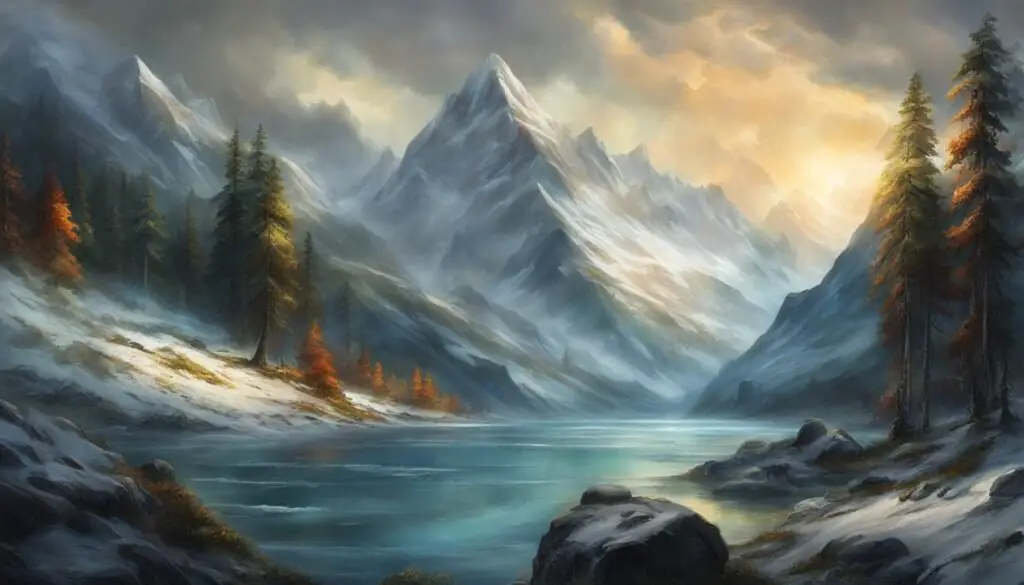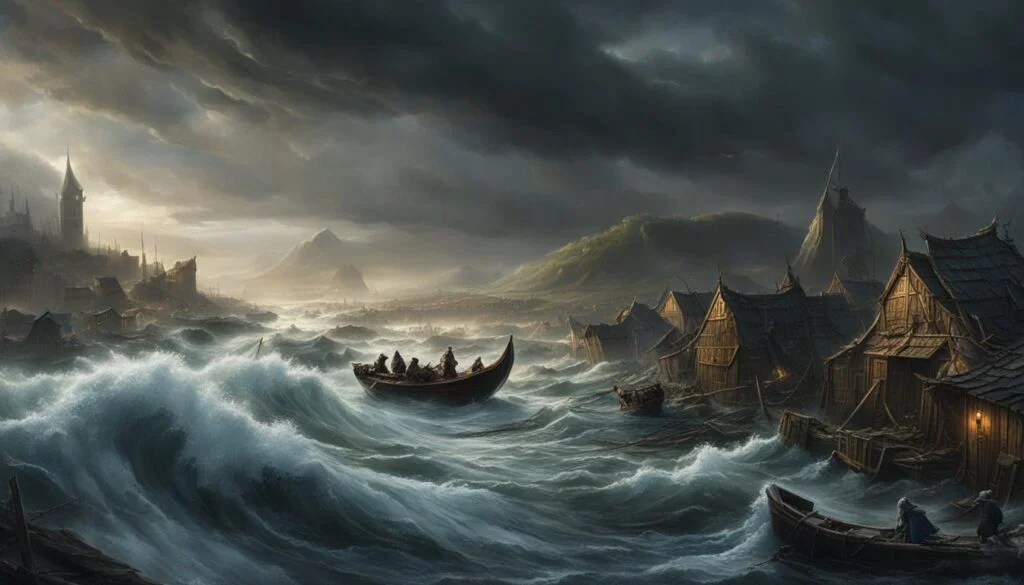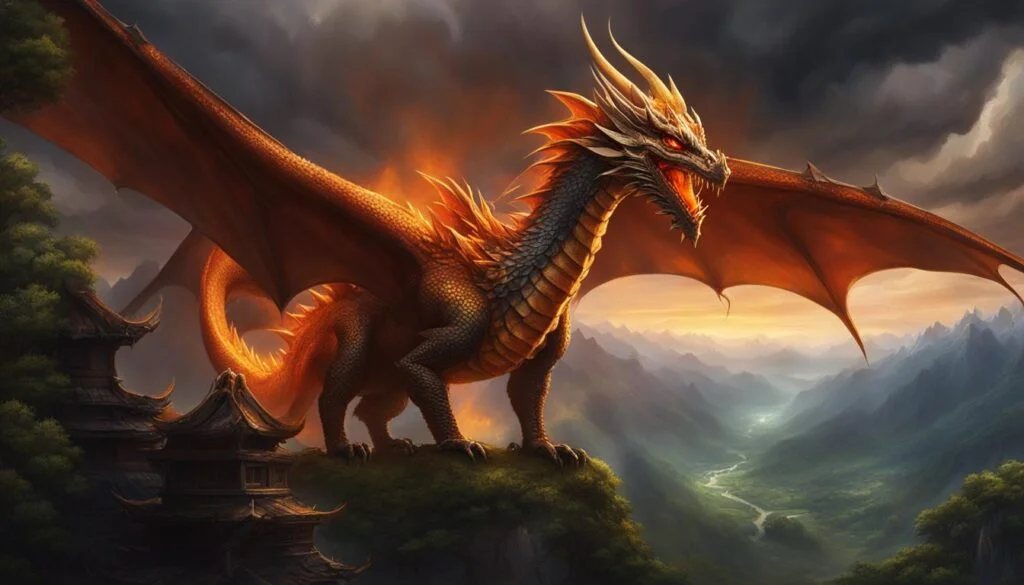In Norse mythology, the cosmos is divided into nine interconnected realms, each with its own unique characteristics and inhabitants. These realms, often referred to as the Nine Worlds, form the backdrop for the epic tales of gods, heroes, and creatures. Understanding the Norse mythos and the cosmology of the Nine Realms provides a glimpse into the rich tapestry of ancient Norse culture and beliefs.
Key Takeaways:
- The Nine Realms in Norse mythology are a complex cosmological structure.
- Each realm has its own distinct characteristics and inhabitants.
- The Nine Realms are interconnected and play significant roles in Norse mythology.
- Exploring the Nine Realms offers insights into the beliefs and values of ancient Norse cultures.
- The gods in Norse mythology inhabit different realms and interact with each other and the mortal realm.
Asgard: Realm of the Æsir
In Norse mythology, Asgard is the realm of the Æsir, the principal gods. It is a place of divine palaces and stands as a symbol of power and majesty. Connected to Midgard, the realm of humans, by the rainbow bridge called Bifröst, Asgard is a realm steeped in myth and legend.
Asgard is not a single entity but is divided into twelve sub-realms, each with its own unique characteristics and inhabitants. One of the most renowned sub-realms is Valhalla, a grand hall where fallen warriors are honored. It is said that those who die bravely in battle are chosen by the Valkyries and taken to Valhalla, where they feast and prepare for Ragnarök, the apocalyptic battle.
- Valhalla is filled with great warriors who await the final battle with the giants.
- Fólkvangr, another significant sub-realm, is presided over by Freya, the goddess of love and beauty. She selects half of the fallen warriors to join her in Fólkvangr.
- Thrudheim is the realm of Thor, the god of thunder. Here, he resides in his mighty hall and wields his hammer, Mjölnir, defending Asgard from enemies and offering protection to the Æsir.
While some sub-realms, such as Valhalla, Fólkvangr, and Thrudheim, are well-documented in Norse mythology, others, like Breidablik and Himinbjörg, are mentioned but not extensively described.
Asgard, with its divine palaces and powerful gods and goddesses, is a central hub in Norse mythology. Its grandeur and significance make it a captivating realm to explore, showcasing the magnificence of the Æsir and their impact on the Norse mythological landscape.
Midgard: Realm of Humans
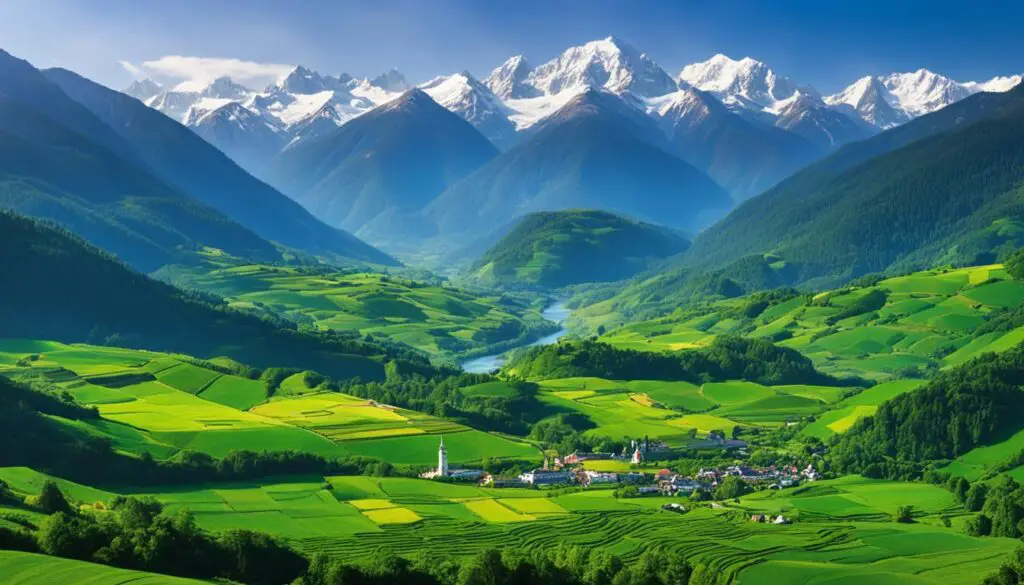
In Norse mythology, Midgard is depicted as the realm of humans, often referred to as the “real world.” Situated in the middle of the Nine Realms, Midgard finds its place on the branches of the World Tree, Yggdrasil. The term “Midgard” translates to “middle enclosure,” representing its position in relation to the other realms.
As the realm inhabited by humans, Midgard is where civilizations flourished and societies thrived. It is a place where humans strive to establish order and maintain a harmonious balance. In Norse mythology, the concept of “innangard” refers to a society characterized by law, structure, and adherence to established norms.
Humans in Midgard played a crucial role in the intricate mythological narrative, interacting with the gods and experiencing their influence firsthand. Their struggles and triumphs were intertwined with the fate of the Nine Realms, shaping the course of events within the Norse pantheon.
Within the realm of Midgard, humans faced various challenges, from daily hardships to epic battles. Legends and sagas recount the tales of heroes, warriors, and ordinary individuals who embodied the virtues and aspirations valued by the ancient Norse cultures.
To visualize the concept of Midgard and its connections, imagine the branches of Yggdrasil reaching across the realms, with Midgard serving as the bustling center of mortal existence. Humans found their place under the watchful gaze of the gods and sought to navigate the complexities of existence amid the vast cosmology of Norse mythology.
Key Points:
- Midgard is the realm of humans in Norse mythology.
- It is positioned in the middle of the Nine Realms on the branches of Yggdrasil.
- Midgard represents the “real world” and is a place where humans strive for order.
- The concept of “innangard” symbolizes a society with law and order.
- Humans in Midgard played a significant role in the intricacies of Norse mythology.
Vanaheim: Realm of the Vanir
Vanaheim is the realm of the Vanir, another group of gods in Norse mythology. While limited information is available about this realm, it is believed to have a more chaotic environment compared to other realms like Asgard and Midgard. The Vanir are closely associated with the natural world, and Vanaheim’s name, ending with “-heim,” suggests a connection to the concept of “home.” Scholars speculate that Vanaheim may have had a nature-aligned and less structured environment.
To get a glimpse into the realm of Vanaheim, imagine a place where unpredictable forces prevail and nature reigns supreme. In this realm, beauty and chaos coexist, shaping a unique and vibrant landscape. The Vanir, gods of fertility, magic, and nature, thrive in this wild and untamed environment, embodying the raw power of the natural world.
While specific details about Vanaheim are scarce, its association with the Vanir and their nature-aligned attributes offers clues to its character. The Vanir, known for their connection to the earth, water, and flora, likely cultivated a deep understanding and reverence for the chaotic yet harmonious rhythms of the natural realm.
As with other realms in Norse mythology, Vanaheim’s enigmatic nature leaves room for interpretation and imagination. It invites us to explore the untamed corners of existence, where wild landscapes and divine powers intertwine.
Jotunheim: Land of the Jötnar
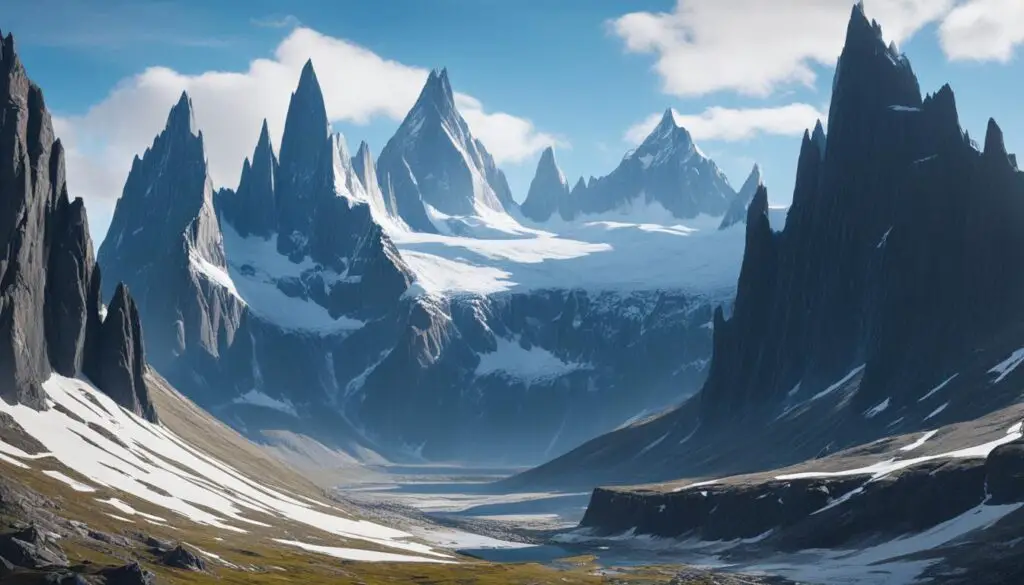
Jotunheim, the land of the jötnar, is a mesmerizing realm in Norse mythology. It is an untamed and chaotic wilderness, adorned with towering mountains, deep forests, and frozen peaks. The very essence of Jotunheim reflects the wild reaches of Scandinavia, with its harsh winters and awe-inspiring natural beauty.
In Jotunheim, the jötnar, or giants, dwell amidst the rugged landscapes and unpredictable elements. These colossal beings embody the raw power and primal forces of nature, existing beyond the confines of civilization. They are both adversaries and allies to the gods, often challenging their authority and invoking chaos within the realms.
The capital of Jotunheim is Utgard, a name that signifies “outside the fence” and represents the concept of chaos in Norse cosmology. Utgard serves as the seat of the jötnar’s power, a place where the boundaries between the known and the unknown blur. It is said that Utgard holds incredible wonders and tests the bravery and resourcefulness of those who dare to venture into its realm.
As the gods journey through Jotunheim, they face the formidable might of the jötnar and confront the unyielding forces of nature. The giants and their homeland serve as a reminder of the untamed wilderness that once dominated the lands of ancient Norse cultures. From the towering mountains to the frozen peaks, Jotunheim stands as a testament to the awe-inspiring beauty and chaotic power of the natural world.
Continue reading to discover more about the realms of Norse mythology as we embark on a journey through the Nine Realms.
Alfheim and Svartalfheim: Realms of Light and Dark
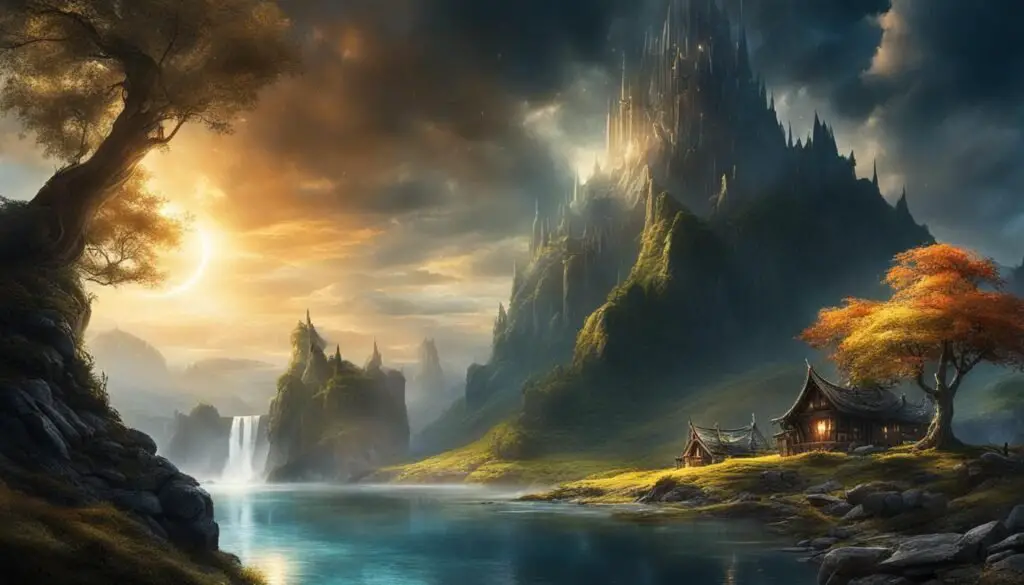
Within the vast tapestry of Norse mythology, two distinct realms stand in stark contrast to each other: Alfheim and Svartalfheim. These realms are inhabited by different beings, each embodying unique qualities and characteristics.
Alfheim: The Realm of Light Elves
Alfheim, the realm of the light elves, is eternally bathed in ethereal beauty and tranquility. It is renowned for its breathtaking landscapes, including lush forests, meandering rivers, and shimmering crystal-clear lakes. Nature flourishes abundantly here, harmoniously intertwining with the realm’s radiant inhabitants.
Light elves are revered for their exceptional artistic and magical prowess. They are known to possess an innate talent for crafting wondrous objects, captivating all who gaze upon their creations. Their magical abilities grant them the power to bring forth healing and fertility, bestowing blessings upon those who seek their aid.
In Alfheim, peace prevails as the light elves foster an environment of harmony and coexistence. Their benevolent nature radiates throughout the realm, weaving a tapestry of serenity and tranquility that enchants those who have the privilege to set foot within its borders.
Svartalfheim: The Realm of Dark Elves
On the other end of the spectrum lies Svartalfheim, the realm of the dark elves or dwarves. Unlike the luminous beauty of Alfheim, Svartalfheim is shrouded in a perpetual gloom, with caverns and subterranean rivers hidden deep within its enigmatic depths.
Within Svartalfheim, the dark elves or dwarves possess exceptional craftsmanship that rivals that of any realm. Their skilled hands fashion extraordinary works, imbued with intricacy and precision. These remarkable artisans craft legendary weapons, magnificent jewelry, and mystical artifacts that possess unparalleled power.
However, the dark elves are not without their complexities. Often portrayed as cunning and treacherous, they inhabit a realm that mirrors the shadows that dance within their hearts. Svartalfheim is a place where secrecy is cherished and trust must be granted with caution.
Deep within the dichotomy of Alfheim and Svartalfheim, the realms of light and dark, beauty and craftsmanship intertwine. These contrasting realms showcase the multifaceted nature of Norse mythology, where every corner harbors tales of mythical beings and their extraordinary abilities.
Nidavellir: Realm of Dwarves
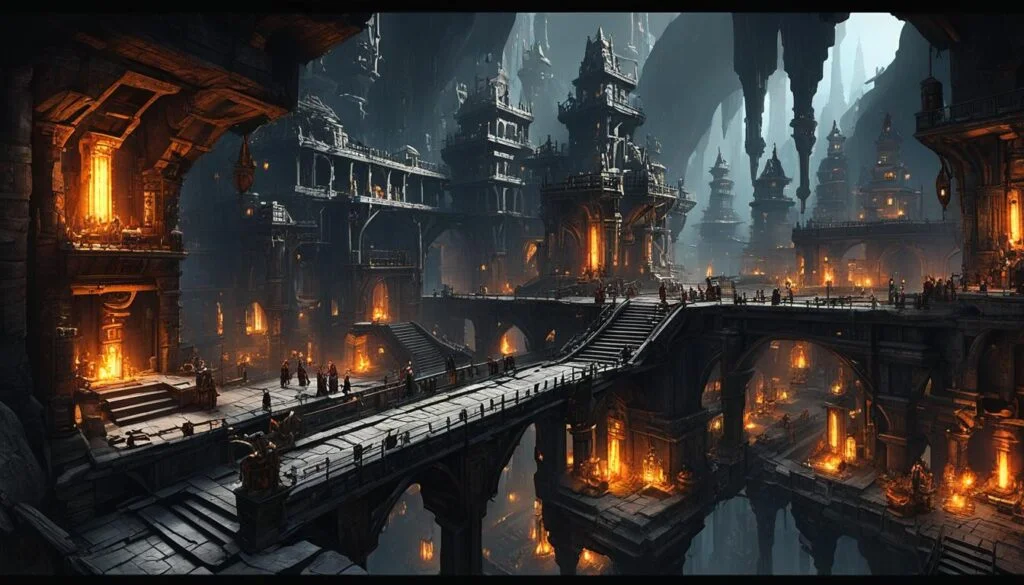
Nidavellir, one of the Nine Realms in Norse mythology, is specifically associated with the dwarves. It is described as the home of these skilled craftsmen, renowned for their exceptional crafting abilities and intricate creations. Within Nidavellir’s halls, the dwarves masterfully forge objects of remarkable beauty and ingenuity.
The halls of gold, such as those associated with the dwarf Sindri, are mentioned in the poetic Edda, a collection of Old Norse poems. These halls exemplify the dwarves’ artistry and craftsmanship, showcasing their ability to transform precious materials into stunning works of art.
However, there is some confusion and overlap between Nidavellir and Svartalfheim, another realm in Norse mythology inhabited by the dark elves or dwarves. Different sources provide varying accounts of these realms, making it challenging to establish clear distinctions.
To further explore the allure of Nidavellir and witness the dwarves’ mastery of intricate crafting, take a look at the image below:
Through the halls of Nidavellir, the dwarves inspire awe and admiration with their unmatched skill and creativity. Their craftsmanship continues to captivate our imaginations, showcasing the rich mythological tapestry of Norse culture.
Niflheim and Muspelheim: Primeval Realms of Ice and Fire
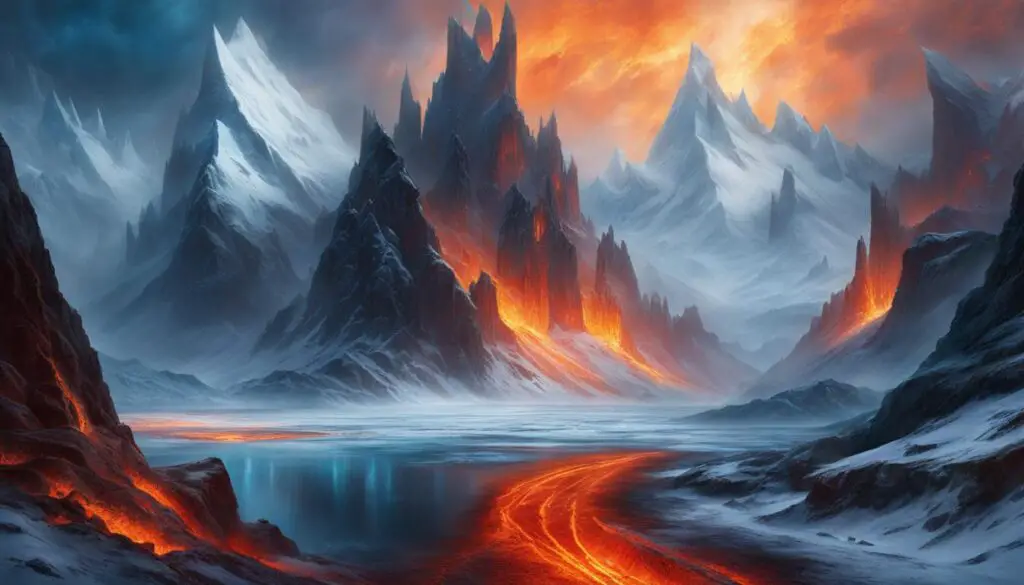
In Norse cosmology, Niflheim and Muspelheim are the primeval realms that existed before the creation of the other realms. These realms are characterized by extreme elements of ice and fire, representing the contrast between cold and heat, darkness and light.
Niflheim: Realm of Frost
Niflheim is the realm of frost and ice. It is a desolate and frigid place, covered in eternal ice. This realm is associated with the frost jötnar, the giants of cold and darkness. Niflheim is known for its icy landscapes, including vast glaciers, frozen lakes, and icy mountains.
According to Norse mythology, the giant Ymir was born from the meeting of the primordial cow, Auðumbla, and the melting ice of Niflheim. Ymir is considered the progenitor of all jötnar and gods, and from his body, the other realms of the cosmos were created.
Muspelheim: Realm of Fire
Muspelheim, on the other hand, is the realm of fire. It is a land of extreme heat and flames, representing chaos and destruction. Muspelheim is home to the fire jötnar, including the powerful Surtr, who wields a flaming sword and plays a significant role in the events of Ragnarok, the end of the world in Norse mythology.
The fires of Muspelheim were believed to bring light and warmth to the cold darkness of Niflheim. The meeting of ice and fire in the void called Ginnungagap led to the creation of the cosmos, including the formation of Midgard, Asgard, and the other realms in Norse mythology.
This image represents the clash between fire and ice, symbolizing the primeval realms of Niflheim and Muspelheim.
The fascinating contrast between Niflheim and Muspelheim showcases the duality and forces of nature that shaped the Norse cosmology. These primeval realms set the stage for the creation of the Nine Realms and the epic stories of gods, giants, and humans in Norse mythology.
Helheim: Realm of the Dead
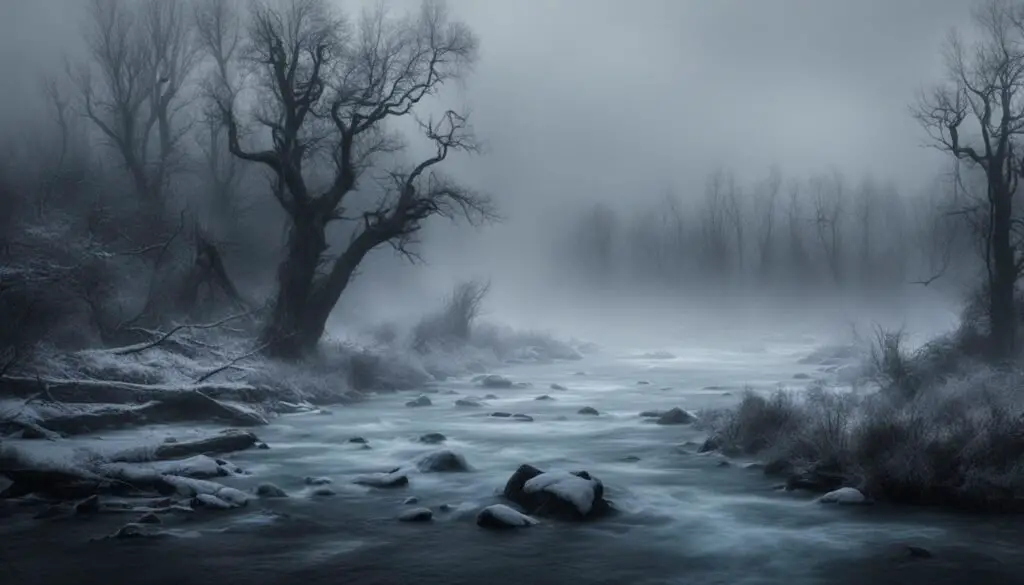
Helheim is the realm of the dead in Norse mythology, often associated with an underworld or the realm of Hel, the goddess who rules over this domain. It is a cold, dark, and gloomy place, resembling a grave. The souls of the departed dwell in Helheim, continuing their existence in a manner similar to their life in Midgard.
In Helheim, the dead engage in activities such as eating, drinking, fighting, and sleeping, mirroring their earthly experiences. Despite its somber nature, Helheim is not portrayed as a place of torment and suffering. Instead, it is a realm where the deceased maintain an afterlife that echoes their previous life.
Through its depiction as an underworld, Helheim plays a crucial role in Norse mythology, representing the realm where the deceased transition to after death. The existence of Helheim adds depth and complexity to the Norse cosmology, providing insights into the beliefs and understanding of the afterlife in ancient Norse culture.
Conclusion
The Nine Realms in Norse mythology offer a captivating glimpse into a rich and intricate cosmology. Each realm has its distinct characteristics, inhabited by gods, creatures, and legends that shape the Norse pantheon. By exploring these realms, we gain a deeper understanding of the mythological significance and beliefs of ancient Norse cultures.
From the divine palaces of Asgard to the chaotic wilderness of Jotunheim, each realm holds its own mysteries and allure. Midgard, the realm of humans, symbolizes the quest for order and civilization, while Vanaheim, the realm of the Vanir, embodies the connection to nature and a less structured environment.
Additionally, we delve into the contrasting realms of light and dark – Alfheim, the realm of the light elves, known for its beauty and artistry, and Svartalfheim, the realm of the dark elves or dwarves, renowned for exceptional craftsmanship. Moreover, realms like Niflheim and Muspelheim take us back to the primeval origins of ice and fire, from which the cosmos emerged.
Lastly, the realm of Helheim provides insights into the afterlife, where the dead continue their existence in a somber yet not tormenting realm. The interconnectedness of these realms, their gods, and their mythological stories create a tapestry of Norse mythology that continues to captivate and intrigue today.
FAQ
What are the nine realms in Norse mythology?
The nine realms in Norse mythology are Asgard, Midgard, Vanaheim, Jotunheim, Alfheim, Svartalfheim, Nidavellir, Niflheim, Muspelheim, and Helheim.
What is Asgard?
Asgard is the realm of the Æsir, the principal gods in Norse mythology. It is a place of divine palaces and is connected to Midgard, the realm of humans, by the rainbow bridge called Bifröst.
What is Midgard?
Midgard is the realm of humans and is often referred to as the “real world” in Norse mythology. It is situated in the middle of the Nine Realms on the branches of the World Tree, Yggdrasil.
What is Vanaheim?
Vanaheim is the realm of the Vanir, another group of gods in Norse mythology. It is believed to have a more chaotic environment compared to other realms like Asgard and Midgard.
What is Jotunheim?
Jotunheim is the home of the jötnar, the giants in Norse mythology. It is depicted as a vast and chaotic wilderness, characterized by towering mountains, deep forests, and frozen peaks.
What are Alfheim and Svartalfheim?
Alfheim is the realm of the light elves and is known for its beauty and harmony. Svartalfheim, on the other hand, is the realm of the dark elves or dwarves, and is described as a gloomy and enigmatic realm.
What is Nidavellir?
Nidavellir is specifically associated with the dwarves in Norse mythology. It is described as the home of the dwarves, known for their exceptional crafting skills.
What are Niflheim and Muspelheim?
Niflheim and Muspelheim are the primeval realms of ice and fire in Norse cosmology. They existed before the creation of the other realms and were separated by an endless void called Ginnungagap.
What is Helheim?
Helheim is the realm of the dead in Norse mythology, often associated with an underworld or the realm of Hel, the goddess who rules over this domain.
What can we learn from exploring the Nine Realms?
Exploring the Nine Realms offers insights into the rich and fascinating world of Norse mythology and the beliefs of ancient Norse cultures. It helps us understand the interconnectedness of the Norse pantheon and gain a deeper appreciation for their mythological significance.


